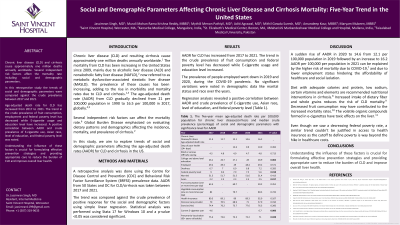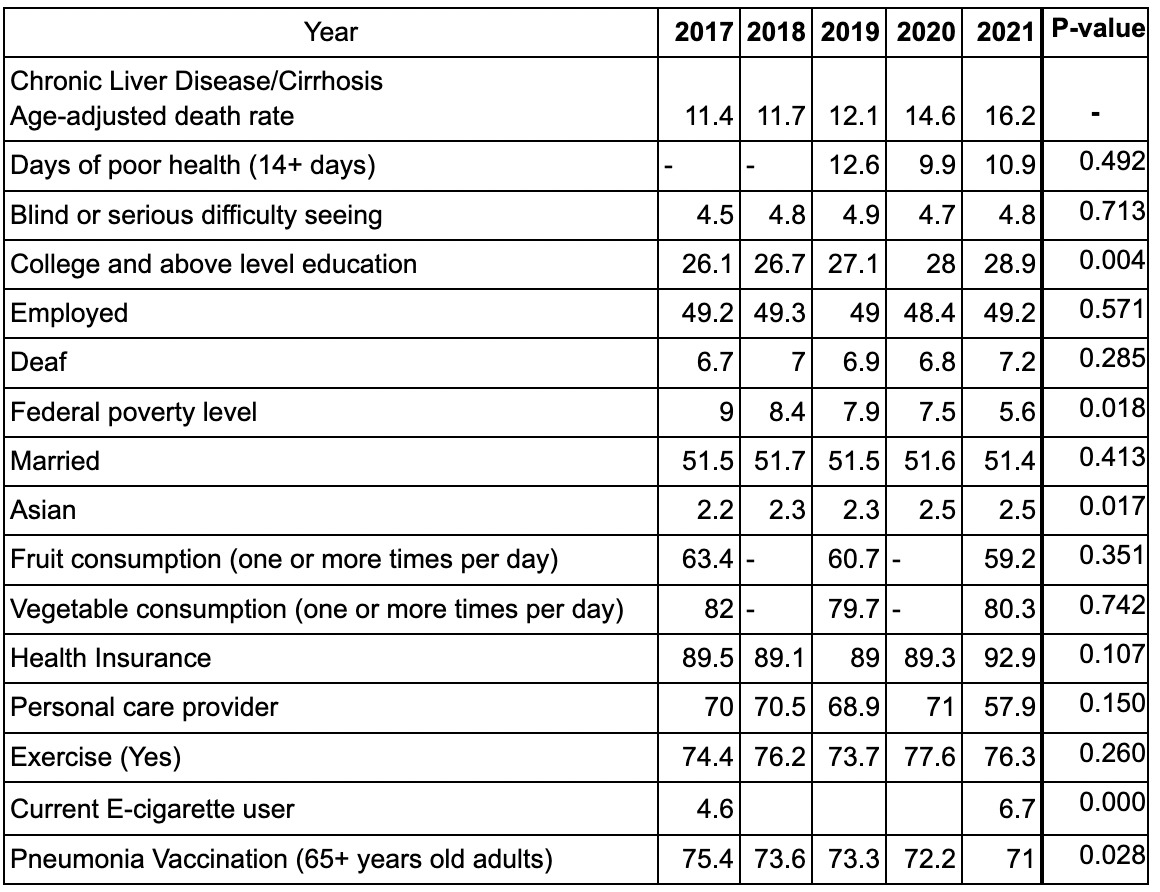Monday Poster Session
Category: Liver
P2398 - Social and Demographic Parameters Affecting Chronic Liver Disease and Cirrhosis Mortality: Five-Year Trend in the United States
Monday, October 23, 2023
10:30 AM - 4:15 PM PT
Location: Exhibit Hall

Has Audio

Jassimran Singh, MD
Saint Vincent Hospital
Worcester, MA
Presenting Author(s)
Jassimran Singh, MD1, Murali Mohan. Rama Krishna Reddy, MBBS2, Mythili Menon Pathiyil, MD1, Aditi Agrawal, MD3, Mithil Gowda Suresh, MD1, Amandeep kour, MBBS4
1Saint Vincent Hospital, Worcester, MA; 2Kasturba Medical College, Worcester, MA; 3St. Elizabeth's Medical Center, Worcester, MA; 4Maharishi Markandeshwar Medical College and Hospital, Solan, Himachal Pradesh, India
Introduction: Chronic liver disease (CLD) and resulting cirrhosis cause approximately one million deaths annually worldwide. The mortality from CLD has been increasing in the United States since 2009, mainly due to alcoholic and nonalcoholic fatty liver diseases. Several independent risk factors affect the mortality rate. Global Burden Disease emphasized evaluating dietary patterns and demographics affecting incidence, mortality, and prevalence of cirrhosis. In this study, we aim to explore trends of social and demographic parameters affecting the age-adjusted death rates (AADR) for CLD and cirrhosis in the US.
Methods: A retrospective analysis was done using the Centre for Disease Control and Prevention and Behavioral Risk Factor Surveillance System prevalence data. AADR from 50 States and DC for CLD/cirrhosis was taken between 2017-2021, the trend was compared against the crude prevalence of positive response for the social and demographic factors using simple linear regression. Statistical analysis was performed using Stata 17 and a p-value < 0.05 was considered significant.
Results: AADR for CLD has increased from 2017 to 2021. The trend in the crude prevalence of fruit consumption and federal poverty level has decreased while E-cigarette usage and education level increased. The prevalence of people employed went down in 2019 and 2020, during the COVID-19 pandemic. No significant variations were noted in demographic data like marital status and race over the years. Regression analysis revealed a positive correlation between AADR and crude prevalence of E-cigarette use, Asian race, level of education, and federal poverty level (Table 1).
Discussion: A sudden rise of AADR in 2020 and 2021 can be explained by the higher risk of mortality due to COVID-19, and due to lower employment status hindering the affordability of healthcare and social isolation. Increased intake of dietary fiber and whole grains reduces the risk of CLD mortality. Decreased fruit consumption may have contributed to the increased mortality rates. The volatile organic compounds formed in e-cigarettes have toxic effects on the liver. Even though we saw a decreasing federal poverty rate, a similar trend couldn't be justified in access to health insurance as the cutoff to define poverty is way beyond the hike in healthcare costs. Understanding the influence of these factors is crucial for formulating effective prevention strategies and providing appropriate care to reduce the burden of CLD and improve overall liver health.

Disclosures:
Jassimran Singh, MD1, Murali Mohan. Rama Krishna Reddy, MBBS2, Mythili Menon Pathiyil, MD1, Aditi Agrawal, MD3, Mithil Gowda Suresh, MD1, Amandeep kour, MBBS4. P2398 - Social and Demographic Parameters Affecting Chronic Liver Disease and Cirrhosis Mortality: Five-Year Trend in the United States, ACG 2023 Annual Scientific Meeting Abstracts. Vancouver, BC, Canada: American College of Gastroenterology.
1Saint Vincent Hospital, Worcester, MA; 2Kasturba Medical College, Worcester, MA; 3St. Elizabeth's Medical Center, Worcester, MA; 4Maharishi Markandeshwar Medical College and Hospital, Solan, Himachal Pradesh, India
Introduction: Chronic liver disease (CLD) and resulting cirrhosis cause approximately one million deaths annually worldwide. The mortality from CLD has been increasing in the United States since 2009, mainly due to alcoholic and nonalcoholic fatty liver diseases. Several independent risk factors affect the mortality rate. Global Burden Disease emphasized evaluating dietary patterns and demographics affecting incidence, mortality, and prevalence of cirrhosis. In this study, we aim to explore trends of social and demographic parameters affecting the age-adjusted death rates (AADR) for CLD and cirrhosis in the US.
Methods: A retrospective analysis was done using the Centre for Disease Control and Prevention and Behavioral Risk Factor Surveillance System prevalence data. AADR from 50 States and DC for CLD/cirrhosis was taken between 2017-2021, the trend was compared against the crude prevalence of positive response for the social and demographic factors using simple linear regression. Statistical analysis was performed using Stata 17 and a p-value < 0.05 was considered significant.
Results: AADR for CLD has increased from 2017 to 2021. The trend in the crude prevalence of fruit consumption and federal poverty level has decreased while E-cigarette usage and education level increased. The prevalence of people employed went down in 2019 and 2020, during the COVID-19 pandemic. No significant variations were noted in demographic data like marital status and race over the years. Regression analysis revealed a positive correlation between AADR and crude prevalence of E-cigarette use, Asian race, level of education, and federal poverty level (Table 1).
Discussion: A sudden rise of AADR in 2020 and 2021 can be explained by the higher risk of mortality due to COVID-19, and due to lower employment status hindering the affordability of healthcare and social isolation. Increased intake of dietary fiber and whole grains reduces the risk of CLD mortality. Decreased fruit consumption may have contributed to the increased mortality rates. The volatile organic compounds formed in e-cigarettes have toxic effects on the liver. Even though we saw a decreasing federal poverty rate, a similar trend couldn't be justified in access to health insurance as the cutoff to define poverty is way beyond the hike in healthcare costs. Understanding the influence of these factors is crucial for formulating effective prevention strategies and providing appropriate care to reduce the burden of CLD and improve overall liver health.

Figure: Table 1. The five-year mean age-adjusted death rate per 100,000 population for chronic liver disease/cirrhosis and median crude prevalence (percentage) of social and demographic parameters with significance level for AADR.
Disclosures:
Jassimran Singh indicated no relevant financial relationships.
Murali Rama Krishna Reddy indicated no relevant financial relationships.
Mythili Menon Pathiyil indicated no relevant financial relationships.
Aditi Agrawal indicated no relevant financial relationships.
Mithil Gowda Suresh indicated no relevant financial relationships.
Amandeep kour indicated no relevant financial relationships.
Jassimran Singh, MD1, Murali Mohan. Rama Krishna Reddy, MBBS2, Mythili Menon Pathiyil, MD1, Aditi Agrawal, MD3, Mithil Gowda Suresh, MD1, Amandeep kour, MBBS4. P2398 - Social and Demographic Parameters Affecting Chronic Liver Disease and Cirrhosis Mortality: Five-Year Trend in the United States, ACG 2023 Annual Scientific Meeting Abstracts. Vancouver, BC, Canada: American College of Gastroenterology.
